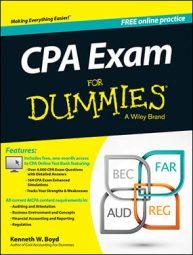For the BEC text portion of the CPA exam, you should be able to perform economic analysis. To properly operate a business, managers need to understand some key economic measures. Managers, for example, consider the company’s industry and competitors. This analysis helps them assess their own financial strengths and weaknesses and make changes to improve profit.
Marginal utility measures customer demand for a product, which also impacts profit. Finally, company profit can be affected by currency values. This chapter considers the impact of currency values on imports and exports.
Reviewing your competition
A business owner needs to understand the competitors in his or her industry. Managers also need to understand how much of a particular market is controlled by one company or a group of companies. A competitor with a large market share may be able to negotiate lower costs paid to vendors because it buys more volume.
By cutting costs for materials, the company with a large market share can reduce their sale price. A competitor’s lower price may force the manager’s firm to cut prices, too, which reduces profit.
Company management can compare their business to the competition by performing scanning. Economists define scanning as collecting data from each segment of a business. Scanning allows a company to assess every aspect of a firm’s business environment.
Suppose that Mountain Range Meats supplies meat and fish to restaurants. Because of the volume of sales, Mountain Range can negotiate lower beef prices with ranchers (its vendors). Mountain Range can then lower its sale prices and maintain the same profit margin (net income divided by sales).
If you manage another meat and fish supplier, the Mountain Range price-cuts put pressure on you to cut your prices. If you don’t, restaurants may move their business to Mountain Range. You see the importance of understanding your competition.
Here are two terms that relate to competition. These terms refer to competitors who may have a great deal of control over the marketplace. That control may allow them to cut prices substantially, which may force competitors out of the marketplace due to lack of profit:
Monopoly: A monopoly is a company that has exclusive control over a particular market. That firm is the only supplier of a specific product or service.
Oligopoly: An oligopoly exists when the market for a particular product is controlled by a small group of firms. In an oligopoly, the actions of one company will greatly impact the prices and sales of the other businesses in the oligopoly.
An oligopoly is formed by horizontal merger. A merger occurs when companies combine their operations into one venture. A horizontal merger takes place when the firms that merge are in the same line of business. Suppose your town has 20 dry cleaners.
Two dry cleaning firms implement horizontal mergers, each with 9 of the other existing dry cleaners. After the mergers, two large firms control all the town’s dry cleaning business. The dry cleaning business is now an oligopoly in your town.
Forecasting sales using marginal utility
Part of any firm’s analysis is forecasting sales. That forecast includes researching how much of a product or service one customer will likely buy. Research on buying habits includes the concept of marginal utility. Marginal utility is the amount of additional satisfaction a customer gains from consuming (buying) one more unit of a product.
For example, after a customer buys one pair of jeans, would she feel enough additional satisfaction from another pair to buy a second one?
The law of diminishing marginal utility states that marginal utility declines with each additional unit received. As the customer uses more units of a product, she gets less satisfaction from each additional item. The customer who buys tickets to three baseball games may not go to a fourth game, because she decides that the additional satisfaction doesn’t justify the cost of a fourth ticket.
Marginal utility is an important factor in forecasting sales, because a company needs to estimate the number of units an individual customer will buy.
Relating currency to imports and exports
Currency risk is the risk that a firm will incur a loss when it exchanges one type of currency for another. The BEC test may include questions about currency risk and how that risk impacts imports and exports.
Suppose that 1 U.S. dollar can be exchanged for 0.60 British pounds. Sterling Shops imports blue jeans from the U.S. At the current exchange rate, Sterling must pay 30 pounds to purchase one $50 pair of blue jeans. Now suppose that the exchange rate changes so that 1 U.S. dollar is exchanged for 0.50 British pounds. Sterling’s cost to buy one $50 pair of blue jeans is now 25 pounds.
Here are some terms that explain this change in currency rates:
Weaker dollar: The value of the dollar is weakened in comparison with the pound. By weaker, economists mean that it takes fewer pounds to buy 1 U.S. dollar.
Stronger pound: The pound’s value is stronger, because 1 pound can buy more U.S. dollars. Instead of needing 0.6 pounds to buy 1 dollar, you now need only 0.5 pounds.
U.S. exports, British imports: Because the pound buys more dollars, it’s now cheaper for Britain to buy goods from the U.S. Economists state that demand for U.S. goods in Britain will increase. U.S. exports will increase, and British imports of U.S. goods will increase.
Your test may cover the relationship among exchange rates, imports, and exports.

